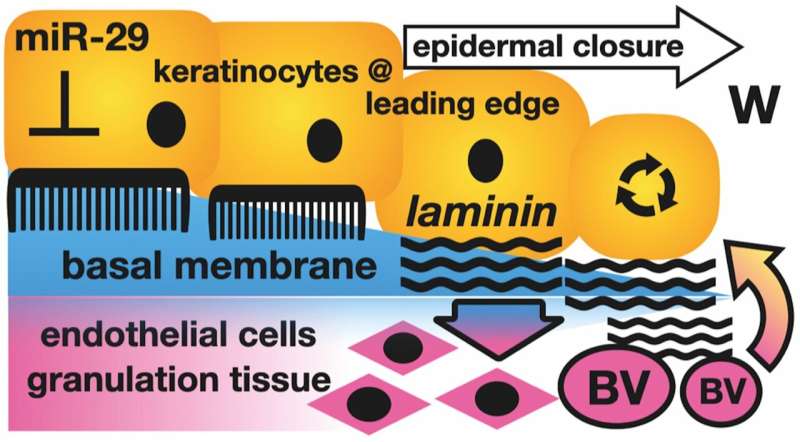This article has been reviewed according to Science X's editorial process and policies. Editors have highlighted the following attributes while ensuring the content's credibility:
fact-checked
trusted source
proofread
Small RNAs take on the big task of helping skin wounds heal better and faster with minimal scarring

Recent findings published in The American Journal of Pathology report that a class of small RNAs (microRNAs) known as microRNA-29 can restore normal skin structure rather than producing a wound closure by a connective tissue (scar). Any improvement of normal skin repair would benefit many patients affected by large-area or deep wounds prone to dysfunctional scarring.
Because the burden of non-healing wounds is so significant, it is sometimes called a "silent pandemic." Worldwide, costs associated with wound care are expected to reach $15 billion to $22 billion US per year by 2024, exceeding the cost of managing obesity-related health problems in some parts of the world.
Lead investigator Svitlana Kurinna, Ph.D., Division of Cell Matrix Biology and Regenerative Medicine, FBMH, University of Manchester, explained, "We had data showing that microRNAs can regulate skin growth. microRNAs do not code for proteins, so it wasn't clear exactly how such small molecules can make changes to the skin. We therefore studied underlying mechanisms that could be targeted to improve cutaneous wound healing."
The molecular events during early wound healing stages of inflammation and tissue formation have been well described using single-cell sequencing and proteomic approaches. microRNAs are important factors in healing and may regulate functions in skin repair; however, the mechanisms underlying tissue remodeling are unclear.
Scientists studying wound healing in microRNA-29 gene knockout transgenic mice suggest that the release of microRNA-29 targets promotes wound healing by regulating skin regeneration by binding long RNAs coding for structural protein laminin C2 (LAMC2) of the skin. This restores the normal skin structure rather than creating a connective tissue scar.
In the current study, researchers noted that wild-type wounded mice healed quite well, but the skin of transgenic mice devoid of microRNA-29 regenerated even better. To understand the reasons, they conducted in-depth microscopic analysis of the transgenic wounds.
They observed deposition of LAMC2—usually found in one of the skin layers in wild mice—around blood vessels inside the wounds of microRNA-29-deficient transgenic mice. This observation indicates that microRNA-29 may be inhibiting the expression of LAMC2, and deletion in the transgenic mice relieved the inhibition, which resulted in faster wound healing.
Dr. Kurinna noted, "These processes are likely mediated by microRNA-29 target microRNAs released upon removal of microRNA-29 to improve cell matrix adhesion. These results further suggest a link between LAMC2, improved angiogenesis, and re-epithelialization. We had expected a different change in skin regeneration; we thought the removal of microRNA-29 would help outer layers of the skin to grow faster, but it was the deep matrix of the wound that showed an improvement."
These findings in both mice and humans demonstrate the role of microRNA-29 in epidermal repair and suggest that the release of microRNA-29 targets, particularly LAMC2, promotes wound healing. The inhibition of microRNA-29 and/or overexpression of LAMC2 may be a new and effective strategy for improving wound healing.
More information: Connor J. Robinson et al, Release of miR-29 Target Laminin C2 Improves Skin Repair, The American Journal of Pathology (2023). DOI: 10.1016/j.ajpath.2023.11.002



















